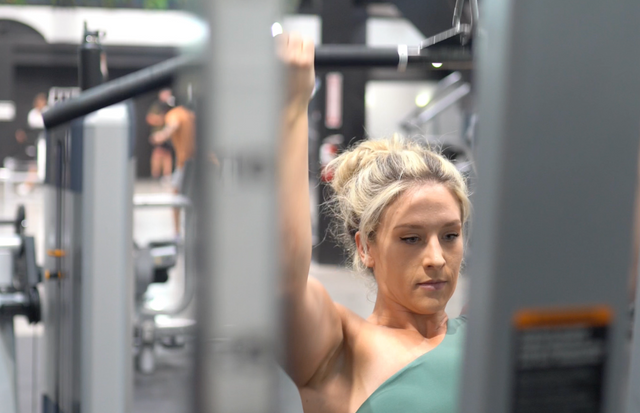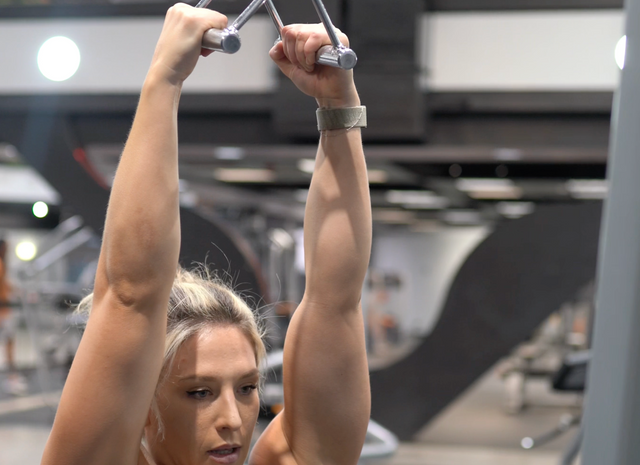Lats Unleashed: The Ultimate Guide to Lat Pulldowns for Strength, Size, and Function
Few exercises rival the lat pulldown in building a strong, wide, and well-developed back. As a staple vertical pulling movement, the lat pulldown targets your latissimus dorsi, the largest muscle group in the upper body, while also strengthening the arms, shoulders, and core. Whether you’re training to build a broader V-taper, improve posture, or develop pull-up strength, this movement delivers.
Performed on a cable machine with a wide overhand grip, the lat pulldown mimics the same pulling mechanics as a pull-up—but with adjustable resistance and a lower barrier to entry. This makes it accessible to beginners and a highly versatile hypertrophy tool for experienced lifters.
In this complete guide, we’ll break down everything you need to know about the lat pulldown—from biomechanics and benefits to proper form, common mistakes, key variations, and how to program it effectively.
What Is the Lat Pulldown?
The lat pulldown is a compound upper-body pulling exercise performed using a lat pulldown machine with a pronated (overhand) grip, typically wider than shoulder-width. The primary purpose of this movement is to strengthen and develop the latissimus dorsi, helping to increase upper-body width and back strength.
Lat pulldowns are classified as a vertical pulling movement, meaning they train the body to pull resistance downward from above, in contrast to horizontal rowing patterns. The adjustable weight stack makes it beginner-friendly, while the consistent resistance from the cable system allows for focused hypertrophy training.
“Lat pulldown exercises elicit high electromyographic activity in the latissimus dorsi and serve as an effective substitute or supplement to pull-up movements.” – Lehman et al., Journal of Strength and Conditioning Research
Benefits of the Lat Pulldown
1. Lat Development and Width
The lat pulldown directly targets the latissimus dorsi, which contributes to back width and the coveted V-taper physique. A well-developed lat sweep creates the illusion of a smaller waist and broader shoulders.
2. Scapular and Shoulder Strength
Pulling through a full range of motion engages the scapular retractors, lower trapezius, and teres major, strengthening the shoulder girdle and improving shoulder mobility and function.
3. Pull-Up Progression
For those working toward bodyweight pull-ups, lat pulldowns provide an excellent training foundation. You can mimic the same movement pattern with controlled loading, which improves technique and strength carryover.
4. Postural Support
By strengthening the muscles responsible for scapular depression and spinal extension, lat pulldowns can help improve posture, especially in individuals with forward shoulder lean or thoracic kyphosis from sitting or screen use.
"Strengthening posterior chain muscles improves spinal alignment and reduces postural compensations caused by sedentary behavior." – Kendall et al., Muscles: Testing and Function
5. Beginner-Friendly Pulling Strength
With adjustable resistance and a fixed movement path, lat pulldowns are ideal for beginners learning vertical pulling mechanics or recovering from injury.
Muscles Worked in the Lat Pulldown
The lat pulldown engages multiple muscle groups throughout the upper body:
-
Latissimus Dorsi (primary mover)
-
Teres Major
-
Lower and Mid Trapezius
-
Rhomboids
-
Posterior Deltoids
-
Biceps Brachii and Brachialis
-
Core Stabilizers (for trunk positioning)
How to Perform the Lat Pulldown Correctly
-
Set Up
Sit down at the pulldown machine. Adjust the thigh pad so your legs are secured. Choose a wide overhand grip on the straight bar—about 1.5x shoulder-width. -
Position Your Body
Sit upright with a slight lean back (about 10–15 degrees). Keep your chest up, core tight, and shoulders down and back. -
Initiate the Pull
Begin by pulling your shoulder blades down and together, then drive your elbows down toward your ribcage. The bar should move toward your upper chest, not your collarbone or waist. -
Pause and Squeeze
At the bottom, pause for a second and squeeze your lats hard while keeping your elbows close to your sides. -
Control the Eccentric
Slowly return the bar to the starting position, allowing your arms to extend fully and feel a gentle stretch in your lats.
Common Mistakes to Avoid
-
Leaning Too Far Back: Turns the movement into a row and reduces lat isolation.
-
Pulling Behind the Neck: Increases shoulder joint stress and decreases lat activation.
-
Using Momentum: Jerking the bar down takes tension off the lats and puts it on joints.
-
Flared Elbows: This limits the range of motion and reduces scapular engagement.
-
Not Controlling the Negative: Fast eccentrics reduce time under tension and growth stimulus.
Lat Pulldown Variations
Adding variety can help break plateaus and target different aspects of back development.
1. Neutral Grip Pulldown
Using a parallel grip to emphasize the mid-back and reduce shoulder strain.
2. Close-Grip Pulldown
Targets more of the lower lats and biceps, allowing for a stronger contraction.
3. Reverse Grip Lat Pulldown
Uses a supinated grip to recruit the biceps and lower lats more effectively.
4. Single-Arm Pulldown
Improves unilateral strength, corrects muscular imbalances, and enhances mind-muscle connection.
5. Kneeling Lat Pulldown
Engages the core and glutes more aggressively for stability while pulling.
“Grip width and hand orientation significantly influence muscle activation patterns during lat pulldown exercises.” – Lusk et al., Journal of Strength and Conditioning Research
How to Program the Lat Pulldown
Lat pulldowns can be performed early in a back workout as a compound movement or later as an accessory lift to further fatigue the lats.
| Goal | Sets | Reps | Rest Period |
|---|---|---|---|
| Hypertrophy | 3–4 | 8–12 | 60–90 seconds |
| Strength | 4–5 | 4–6 | 2–3 minutes |
| Endurance/Conditioning | 2–3 | 15–20 | 30–60 seconds |
Train 1–2 times per week, ensuring proper recovery between sessions. Pair with rows, face pulls, and scapular-focused exercises for balanced development.
Complementary Exercises
Round out your pulling routine with movements that target different planes and muscle groups:
-
Pull-Ups – Advanced vertical pull for maximal bodyweight strength
-
Barbell Bent-Over Rows – Emphasizes mid- and lower-back thickness
-
Dumbbell Pullovers – Enhances lat length and chest expansion
-
Face Pulls – Improves rear deltoid strength and scapular mobility
-
Deadlifts – Full posterior chain development, from glutes to traps
Conclusion: Why Lat Pulldowns Should Be in Your Training Program
The lat pulldown is a cornerstone exercise for building a strong, wide, and functional upper body. Its versatility, accessibility, and ability to isolate key pulling muscles make it a go-to for beginners and advanced lifters alike. Whether you're training for aesthetics, strength, or posture correction, lat pulldowns provide the foundational stimulus needed for upper body success.
Train them consistently. Focus on form. Progress with intent. And watch your back grow stronger—rep by rep.
Find similar articles:
Fitness






